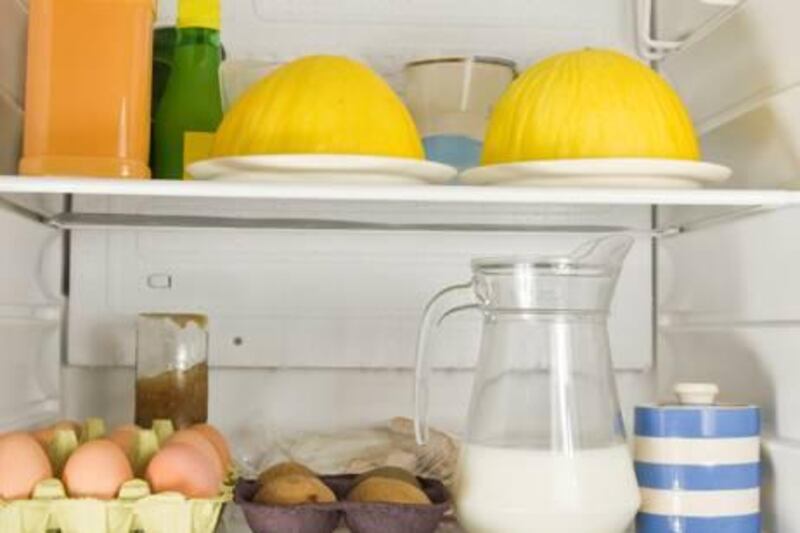Above average use of your fridge and oven during busy times such as Christmas can cause a build-up of grime, dirt and bacteria that can prove a nightmare to clean in the new year. So to avoid a nasty start to 2012, get your kitchen appliances sparkling and germ-free now so your post-festive clean-up is a breeze.
Oven
Before you start, make sure that your oven is completely cool. However, it will help if the oven has been used recently because the grease will be softened and easier to remove.
Open all the windows to air the room as you clean. Wear protective gloves, a mask and an old apron - this is a messy job.
If you'd rather not use strong chemicals, remove all shelves and grill pans. Leave them to soak in the sink (or in a special oven rack tray, available at Lakeland) in hot water and washing-up liquid.
Sweep out loose debris such as burnt crumbs from the oven floor.
Make a paste using bicarbonate of soda and water, then smear it inside the oven on all the surfaces.
Leave it overnight, then use a scourer and water to scrub the dirt out. Rinse well and leave to dry with the door open.
Scrub the shelves, rinse them thoroughly and leave to drip dry before putting them back in the oven.
If you're happy to use strong chemicals, remove all shelves and take them outside. Coat them with a specialist oven cleaning product such as the award-winning (odourless) Oven Mate Cleaning Gel and an applicator brush. Put them in a bin bag to soak so dirt and grease loosen.
Sweep out loose debris such as burnt crumbs from the oven floor.
Coat the oven floor, ceiling, walls and door with the gel and leave it to work for between three minutes and three hours depending on how dirty your oven is.
Rinse and scrub your oven shelves using a hose and a scourer. Wash in warm soapy water, rinse and leave to drip-dry.
Wipe out the oven with a damp cloth and rinse well. Leave to dry with the door open.
Microwave
Sweep out loose debris from the microwave floor.
Cut a lemon into slices and place them in a bowl. Fill the bowl halfway with tap water.
Place the bowl in the microwave and heat it on high for three minutes so that the steam loosens dirt and baked-on food.
Carefully (using oven gloves) remove the bowl. Wearing rubber gloves, wipe down the interior of the microwave using a sponge or damp cloth. Leave it to dry with the door open.
If a strong food odour remains, place a bowl of coffee grounds or bicarbonate of soda inside the microwave overnight to absorb the smell.
Refrigerator
Remove all food temporarily. Throw out anything past its use-by date. Store remaining food in a cool box with ice blocks so harmful bacteria don't multiply while you clean.
Take out all the empty compartments, drawers and shelves, then wash them in warm, soapy water and rinse well. Leave to drip dry.
Wipe the inside of the refrigerator with a damp cloth and a mild non-toxic disinfectant cleaner.
Use an old toothbrush to clean grime from the rubber door seal.
Tackle any stubborn stains inside the refrigerator with a little white toothpaste and a cloth. This will bleach the area, so take care.
Vacuum any fluff from the elements at the back of your refrigerator (if you can reach the back) so it runs more efficiently.
Replace dry drawers and shelves. Put your food back inside.
Freezer
Remove all food temporarily. Store remaining food in a neighbour's freezer or a cool box with ice blocks so food doesn't thaw out while you clean.
Turn the freezer off and prop open the door.
Place a pile of old towels or absorbent cloths in front of the freezer and put a bowl of steaming hot water in the bottom of the freezer to help the ice to melt. When the ice has all melted, dry up any puddles.
Wipe the inside of the freezer and all drawers with a damp cloth and a mild non-toxic disinfectant cleaner. Dry thoroughly with a clean tea towel.
Vacuum any fluff from the elements at the back of your freezer (if you can reach the back) so it runs more efficiently.
When the freezer is cold again, put your food back inside.
Prevention is better than cure
Keep on top of kitchen cleaning throughout the holiday period and you'll avoid a mammoth clean-up session afterwards.
• After it has cooled, wipe your oven out after each use with a damp cloth. This requires discipline but will pay off.
• Line your oven with a Magic Oven Liner, Dh79 for 50cm x 50cm at Lakeland. It's a heavy-duty non-stick material that's heat-resistant up to 260°C. Cut it to size with scissors, then place it in the bottom of your oven to catch debris. You can remove it for cleaning and even stubborn burnt-on spills will glide off.
• Don't attempt to clean the oven if you're pregnant or have breathing problems. Keep children and pets away from oven cleaning products and fumes. Always check and follow manufacturer's instructions.
• Store food in sealed plastic containers in the refrigerator to avoid spills and residues. Place a kitchen towel under damp items such as milk bottles to absorb condensation and drips.
• Keep older food at the front of the refrigerator and newer food at the back to avoid bacteria growth and decomposition.





